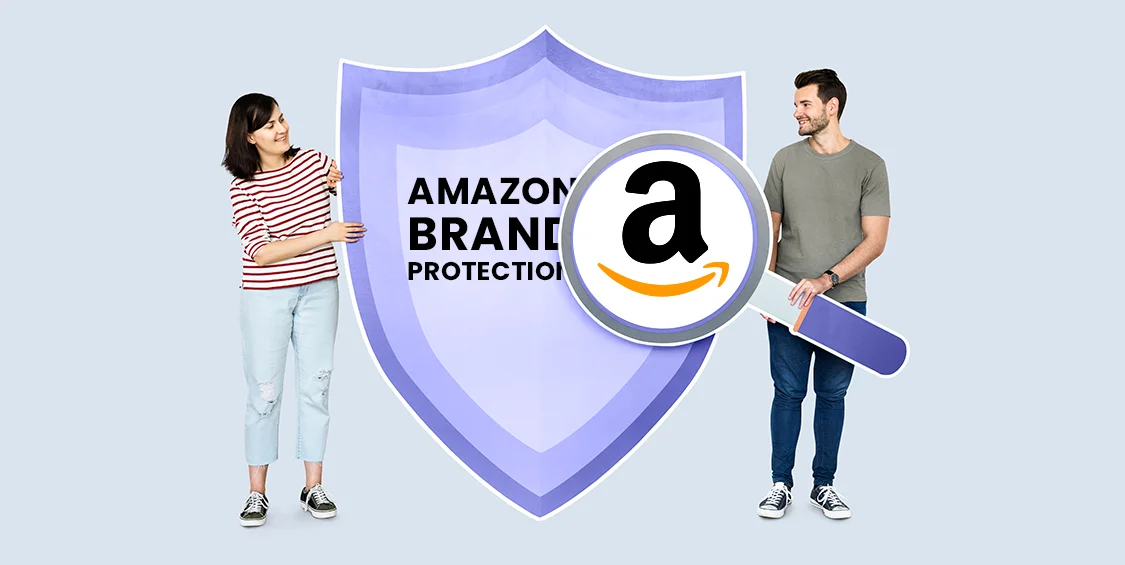Building your brand’s reputation on a platform as competitive as Amazon takes years of hard work and investment. It sounds unfair when someone just sweeps in and cuts your profits, making cheaper versions of your products or damaging your brand’s image with poor quality. Sadly, this scenario is more common than you think for many authentic Amazon sellers.
But do not fret! Continue reading to learn how to fight against them to protect your brand on Amazon.
Strategy#1: Enroll Your Brand With Amazon
Registering with Amazon Brand Registry is an excellent step in protecting your store’s reputation. Through your Brand Registry Account, enroll your brand with Amazon. This safeguards your intellectual property and prevents unauthorized sellers from infringing on your products and listings.
1. Create your Seller Central Account. Click here to get started.

2. Register in the Amazon Brand Registry using the same credentials as the Seller Central Account. Click Here to get started.

3. Once registered into the Amazon Brand Registry, you can use your portal to enroll your brand with Amazon.
4. Open your Amazon Brand Registry Account > Click ‘Enroll a new brand.
Related Reading: Amazon Brand Registry: Roles and Benefits Explained in Detail
Strategy#2 Using Amazon Brand Registry Tool
Anyone selling goods on Amazon, the largest online marketplace in the world, needs to take precautions to safeguard their brands. The Amazon Brand Registry can help companies safeguard their intellectual property. Among the many advantages that this registry offers in the battle against counterfeit goods are the following:
- You will have more control over how your brand is presented on Amazon because you can create and manage product pages for your registered products
- Participate in Amazon’s A+ Content program, which will help you boost your product listings with rich media content.
- Brand Registry allows you to report any unauthorized seller or an IP violation directly.
Strategy#3 Avoid Amazon Trademark Infringement
A trademark is a logo or phrase identifying your firm as the source of a specific commodity or service. The legal protection it provides ensures that no one else may use your trademarked product name, logo, or other brand identifiers. Among those advantages is the fact that you can:
Enjoying monopoly status about the registered goods and services. Protecting your brand from Amazon trademark infringement can stop competitors from stealing your customers and benefiting from your good name without your knowledge or consent. It also facilitates legal action if they do.
Your brand will be accessible for consumers to recall. When you register your brand as a trademark, you do more than just safeguard it against unauthorized use; you also help customers tell your items apart from the competition. Customers often make snap judgments about a company based on its trademark, so it’s crucial to pick one that stands out.
For this reason, taking the necessary steps to protect your brand on Amazon through trademark registration is crucial. It’s a fantastic method to let Amazon shoppers know that your product is one of a kind and 100% genuine. Securing your brand’s identity through trademark registration is essential to building a successful business and preventing Amazon trademark infringement.

Click here to register your brand’s trademark now!
Strategy#4 Highlight your brand’s unique qualities.
To apply to the Amazon Brand Registry, you must maintain a public website for your brand and demonstrate domain ownership. Your product (and packaging) should prominently feature your company’s name. In addition to being a necessary step in the Brand Registry, this will also aid in detecting counterfeit goods (more on that below).
Strategy#5 Identify Unauthorized Sellers and Take Strong Action
Create a data set of Amazon sellers‘ most prolific repeat offenders with multiple listings. These sellers almost certainly need their supply lines severed at the source. Start by concentrating on these prominent infringers.
You can find details about resellers on their Amazon storefront, so you should start there. This could be an assortment of a company’s name, phone number, street address, and electronic mail address.
Whether you have a database of distributors or dealers for your brand, you can use it to see if there is a match.
If no results are seen, you may want to check with a customer since they may be an “indirect dealer” through your distributor.
It’s time to stop making excuses and do something. Make sure to mention the appropriate contact for your brand when sending a cease and desist letter to a reseller by certified mail or email.
Strategy#6 Buy Your Product From The Unauthorized Seller
You can check the stock and make a direct purchase from the distributor. The primary reason for serialization is for use in your company’s inventory management or enterprise resource planning software. Using the serial number, you can determine which wholesaler or retailer bought the product from your company.
In case of a breach of this Agreement, a notice to cease in their current form shall be immediately needed. This notification must be sent by registered mail. However, if the item is genuine but only a few of your products were advertised, you should either disregard it or buy them all.
If they know the rules and decide to take revenge by posting you a one-star review, your strongly worded email requesting them to stay off your listing could backfire terribly.
If they have more than a few of your products, find their supplier and cut them off your source. There are a few ways resellers can grab your products in bulk and resell them for cheaper prices online:
- They could get your product much cheaper elsewhere (e.g., during one of your sales or giveaways).
- Amazon uses the Amazon Warehouse program to resell the “used” returns (that they have reimbursed you for, so now own).
- Amazon is using its Amazon Warehouse program.
Strategy#7 How To Handle Amazon Copyright Infringement
When you create something, you immediately become the sole owner of the copyright, unlike with patents and trademarks. You have the copyright on everything in your listing, including the images and video you created of your product. Anyone who copies your content without your approval falls under Amazon copyright infringement crime.
The following are options available to you if you discover a copyright violation by another vendor:
- Write a cease and desist letter to the vendor.
- Use the Brand Registry account to submit a complaint to Amazon’s Brand Registry.
Amazon may only take action if you consult a lawyer and launch a lawsuit against an Amazon seller denying that they are infringing your copyright and removing their listing.
Final Thoughts
Protecting your brand on Amazon can barely be a sure thing. Someone with malicious intent may be watching you closely, keenly waiting for an opportunity to cut into your profits.
Amazon is constantly working on making its marketplace as secure as possible to retain the trust of its users. The e-commerce giant offers different programs to make protecting brands for sellers as breezy as possible. These include the Transparency, Project Zero, and Counterfeit Crimes Unit.
Register your brand as a trademark, add your brand to the Amazon Brand Registry, and investigate further Amazon programs for which you may qualify if you seriously contemplate building a brand and wish to avoid incurring Amazon copyright infringement or any other violations.
Related Reading: Amazon Account Verification: What the INFORM Act Means for Your Business





